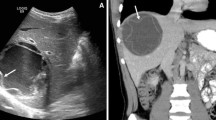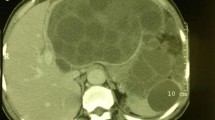Abstract.
Hydatid disease (HD) may develop in almost any part of the body. The liver is the most frequently involved organ (75 %), followed by the lung (15 %) and the remainder of the body (10 %). Hydatid cysts with unusual localizations may cause serious problems in the differential diagnosis. In this article the various imaging findings of hydatid cysts with unusual localizations are reviewed, based on our experience. Findings in brain, heart, pericard, kidney, intraperitoneum, retroperitoneum, bone, soft tissue, and breast are discussed. Hydatid disease should be considered in the differential diagnosis of all cystic masses in all anatomic locations, especially when they occur in areas where the disease is endemic. The combination of clinical history, imaging findings, and serologic test results usually help the diagnosis.
Similar content being viewed by others
Author information
Authors and Affiliations
Additional information
Received: 22 June 1999, Revised: 25 January 2000, Accepted: 29 March 2000
Rights and permissions
About this article
Cite this article
Engin, G., Acunaş, B., Rozanes, İ. et al. Hydatid disease with unusual localization. Eur Radiol 10, 1904–1912 (2000). https://doi.org/10.1007/s003300000468
Issue Date:
DOI: https://doi.org/10.1007/s003300000468




